

| Trade log-in: | HERE | |
| Get password | Forgot password | ||

2015.3 | 2015.2 | 2015.1
2014.3 | 2014.2 | 2014.1 | 2013.3 | 2013.2 | 2013.1 | 2012.3 | 2012.2 | 2012.1
2011.3 | 2011.2 | 2011.1 | 2010.3 | 2010.2 | 2010.1 | 2009.3 | 2009.2 | 2009.1
2008.3 | 2008.2 | 2008.1 | 2007.3 | 2007.2 | 2007.1 | 2006.3 | 2006.2 | 2006.1
2005 | 2004 | 2003 | 2002 | 2001 | 2000
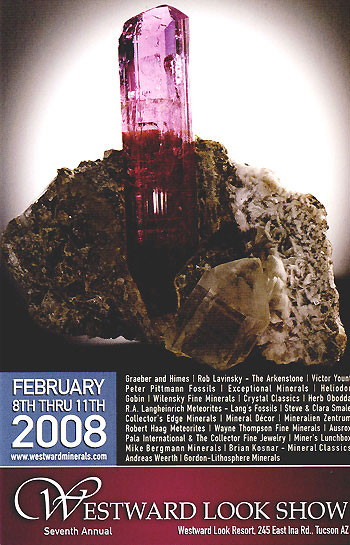 |
Following the holidays, make your plans for the world’s greatest gem and mineral show in February.
See Pala International’s page on the Westward Look Show site.
Pala International will be represented in Tucson as follows.
Event: AGTA GemFair
When: February 6–11, 2008
Where: Tucson Convention Center
Booth: 1016–1018
Event: Westward Look Mineral Show
When: February 8–11, 2008
Where: Westward Look Resort
Suite: 236
Website: Official show website
Event: 54th Annual Tucson Gem and Mineral Show
When: February 14–17, 2008
Where: Tucson Convention Center
Booth: Aisle 5 East
We look forward to seeing our many friends there. Visit the Pala International Show Schedule for future events. [back to top]
This month’s feature is a full-figured natural beauty. Weighing in at 104.76 carats this healthy and happy sapphire from Sri Lanka is a natural blonde, very clean on the inside and well formed on the outside. This sexy stone is reminiscent of a canary diamond with excellent brilliance and a pure lemon-yellow hue.
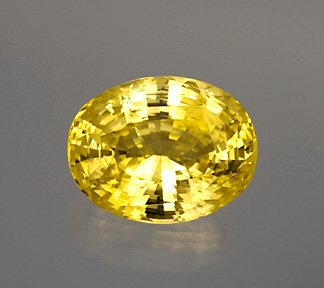 |
| Natural yellow sapphire, 104.76 cts., 30.2 x 23.60 x 16.80 mm. Search on inventory number 14982. (Photo: Wimon Manorotkul) |
A perfect companion for a night out on the town or just a cozy winter evening by the fire. She is a handful, but sure to make your dreams come true.
Interested? Select the inventory number above, call, or email us to see if she’s available. [back to top]
Last month, American Gemological Laboratories (AGL) announced the modification of its disclosure policy on lead-glass filled rubies. In its reports, the lab will term such treated material as “composite ruby,” noting heat and lead-glass as the standard and additional enhancements, respectively.
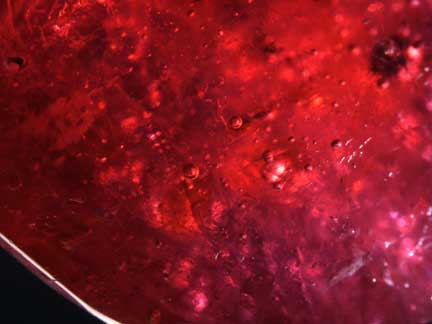 |
| Gas bubbles are a give-away indicator of lead-glass filling (above). Fracturing, due to damage of the filling (below), is another sign. (Photos: Christopher P. Smith, AGL) |
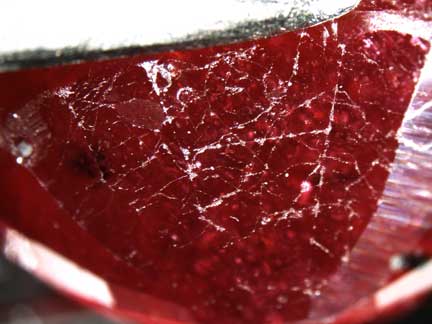 |
According to an AGL press release, the treatment can turn “very low quality ruby that was available in massive quantities… into more transparent, facet-grade ruby via a multiple-step process that involves stages of heating, acid cleaning, as well as injecting a high-refractive index glass.” While such rubies can fool the layman, the game is up when lead-glass becomes easily etched with ordinary household solvents.
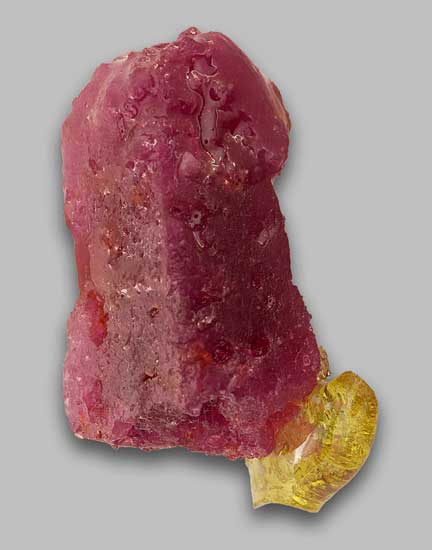 |
| Yellow lead-glass used to treat this ruby rough is still attached. The glass’s color helps to artificially augment the gem material’s natural color. (Photo: Fred Kahn and Sun Joo Chung, courtesy AGL) |
[back to top]
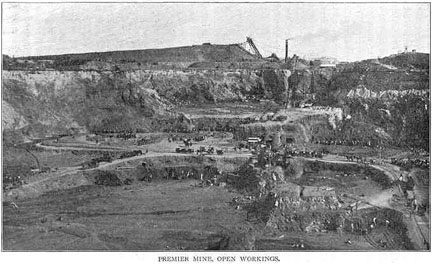 |
| Cullinan Diamond Mine, from The Diamond Mines of South Africa by Gardner Fred Williams, 1905. |
De Beers is selling the historic Cullinan Diamond Mine to a consortium led by Petra Diamonds, the second largest producer of diamonds in South Africa. The Cullinan Diamond Mine was founded in 1902 as the Premier Diamond Mine and has been not only active since then but has produced some of the earth’s greatest diamonds.
In 1905 the single biggest diamond crystal ever was pulled out of the Cullinan pit, weighing 3,106.75 carats. This enormous rough crystal also produced two of the largest polished diamonds in the world. The largest was the Cullinan I (Star of Africa), which weighed in at 530.2 carats, and the Cullinan II (Lesser Star of Africa) at 317.4 carats.
The Cullinan also produces the only significant supply of natural blue diamonds in the world.
The newly named Petra Diamonds Cullinan Consortium apparently bought the mine for 1 billion rand (147 million USD). The new consortium brings about a strong black empowerment element that diversifies De Beers involvement with the long-lived South Africa diamond trade. Read more on the sale in this JCKonline story. [back to top]
 |
The Nuclear Regulatory Commission (NRC) has decided against taking action on current inventories of blue topaz, it was reported by National Jeweler on December 7.
While the NRC has been putting into place revisions of regulations regarding irradiated gemstones, including blue topaz, the fate of existing inventories was uncertain for months. An NRC spokesman told National Jeweler that the agency was employing “enforcement discretion” in the case of existing stock of blue topaz.
On December 4, the NRC updated its Naturally-Occurring and Accelerator-Produced Radioactive (NARM) Toolbox, which contains regulatory information on irradiated material, including gemstones.
On November 8, the NRC announced that “[t]wo distribution licenses have now been issued for neutron-irradiated topaz, and other applications are being reviewed.” The licenses are mentioned in the agency’s “Fact Sheet on Irradiated Gemstones.” The fact sheet includes answers to frequently asked questions for consumers as well as jewelers and distributors.
In a press release dated November 9, the trade organization Jewelers of America named the licensees as being Ideal Source Quality Assurance in Columbia, MO, and HBM Virginia in Warrenton, VA.
A now-deleted eBay forum thread from October 25 includes posts by former AGTA president Rick Krementz, who states that his “facility for testing irradiated gemstones” will be licensed in January 2008. A Google cache of the discussion is available here. [back to top]
By our estimate, since 1964 Burma has earned over $1.245 billion from jade, gem, and pearl sales—more than $645 million since October 2006 alone. See our updated Burma Gem Sales and Statistics.
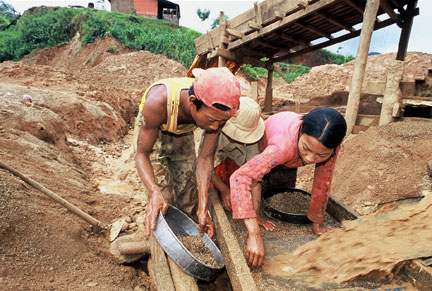 |
| Mining in Mogok. Ruby mining in Burma’s Mogok Stone Tract. (Photo © 2004 Richard W. Hughes) |
The Mid-Year Myanma Gem Emporium 2007, postponed from October, earned $150 million according to an item in The Myanmar Times, dated December 3–9. The online weekly attributed the information to a Myanma Gems Enterprise staff member who was quoted by Agence France-Presse. A total of $300 million worth of jade, gems, and pearls was on offer, including a 171-kg jade block valued at 80 million euros. The block was not sold.
During the sale, a meeting of joint-venture jade and gem mining companies met with government officials. Once again Minister of Mines Brig-Gen Ohn Myint “urged entrepreneurs to make innovation to be able to sell quality finished items rather than selling uncut jade and gems,” according to the official New Light of Myanmar newspaper. [back to top]
A pearl sale that ended November 30 resulted in over 90 percent of the lots on offer being sold, according to The Myanmar Times, an online weekly. According to the article, 33,030 pearls were sold out of a total of 36,025 offered exclusively to domestic traders. U Sein Lwin, general manager of Myanmar Pearl Enterprise (MPE) is quoted: “Revenues from this sale are much higher than any of the other domestic pearl auctions we’ve previously held.”
U Sein Lwin mentioned that this year’s pearl harvest will reach 400,000 pieces. [back to top]
This past spring and summer (July, Aug) we reported on Burma business tycoon’s operations in Phakant, in northern Burma’s Kachin state. An update by Kachin News Group was published November 20. The article explains changes in the system governing the three-year leases of one-acre jade mining blocks.
Since early this year, several jade mining companies could not procure jade mining blocks directly from Burma’s Ministry of Mines and they had to buy the blocks from Te Za’s Htoo Trading Company, a local jade dealer told KNG today. Te Za has the blessings of junta supremo Sr-Gen Than. …
In previous years, the Ministry of Mines had sold all jade mining blocks through tender and competitive bidding systems to mining companies but the system was changed since early this year, the [jade] dealers added.
See the story for two photos of the mechanized mining operations. [back to top]
The Burma government’s Central Statistical Organization, under the Ministry of National Planning and Economic Development, has issued its foreign investment figures for FY2006–07. A total of $752.7 million was invested in 12 enterprise areas, with $471.48 going to Oil and Gas, and another $281.22 going to Power. The figure for the Mining sector was unavailable, but ranges from $0.7–6.0 million over the previous three years. The $750-million total pales in comparison with the previous year—$6.066 billion.
The only investing countries listed are China ($281.2 m.), South Korea ($37 m.), Russia ($33 m.), Singapore ($160.8 m.), and the United Kingdom ($240.7 m.). [back to top]
— End December Newsletter • Published 12/16/07 —
Monday afternoon, October 29, I pick up my lifelong friends Erica and Harold Van Pelt on the way to LAX and an outbound Lufthansa flight to Munich. We have time together to catch up on many things, including our excitement of seeing the special exhibit of gems and minerals from the “roof of the world”—the Himalayan mountains: Afghanistan, Pakistan, and Nepal.
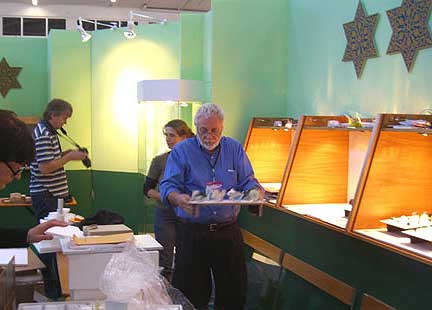 |
| That’s no salad bar. Herb Obodda, an authority on precious stones of the Himalayas, carries some of his specimens to be included in this year’s special exhibition at the Munich show. (Photo: Bill Larson) |
This will be the 44th annual Munich Mineralientage. I applaud Johannes Keilmann, his lovely family, and his great staff for putting on the finest and largest mineral and gem show in Europe. What a great effort—and it shows. I remember from the mid 1970s a much smaller show (albeit a very charming one). I have visited the Munich show more than 30 times.
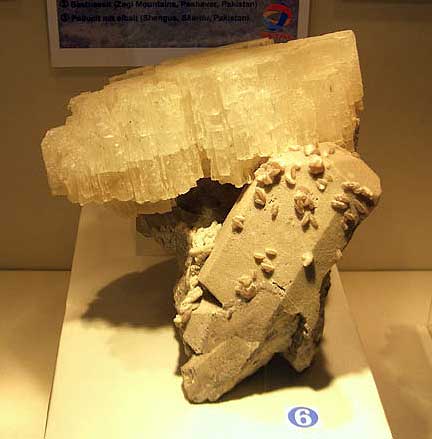 |
| From the land of Rumi. This Afghan beryllonite, courtesy the National Museum of France, is perhaps the finest specimen of its size, (Photo: Bill Larson) |
The Hotel Seibel and the Krone are in downtown Munich and still house many of the collectors/dealers of the Munich show so I stay here and commute by U-bahn. Simple and efficient, the underground goes right to the Messe (fair). I arrive at the show on Wednesday morning and activity is all around the three halls. Little is set up yet and I see a few of the usual suspects, many American collector and dealer friends, including Scott Wersky, Ross Lillie, Victor Yount, Mike Bergman, Andy Seibel, Bill and Carol Smith, and Barry Yampol. Each of us have friendly European dealers who hope to show us something first, but the competition is fierce and fun.
I am most excited about the special exhibit but it will not start to be set up until tomorrow. I greet each dealer in the pavilion for advanced mineral specimens and get a realization of what the dollar buys at 1.44 to the euro; this time purchases must be specific and carefully negotiated. I have a large customer base and long-term relations with Munich dealers, so I am able to get a few fine selected things in this first day.
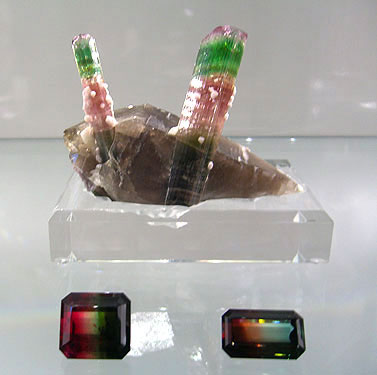 |
| Multi-color tourmaline. This display came complete with its own soundtrack. (Photo: Bill Larson) |
Thursday I am still hunting fine minerals and gems, but by noon I’m invited to help set up the special exhibit with a few friends contributing specimens. Kudos to Keilmann for purchasing the special cases that many of us have gone to in the Westward Look show. Custom-made anodized metal in black or (as here in Munich) white, with a myriad of fiber optic lights to highlight gems and minerals with heat-less but intense light. Herb Obodda is featured both in the show catalog and in the display. and he is busy setting up not only the collections he showed in Tucson but many more. The National Museum of France has a great selection of rare minerals including the finest large beryllonite I have seen.
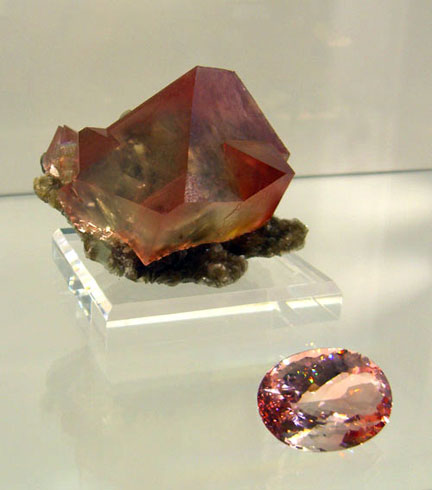 |
| Fluorite. One of the rough/cut pairs from the whitecases at the Munich show. (Photo: Bill Larson) |
The central whitecases are being set up with minerals from various sources and the pieces are all superb. The large multi-color tourmaline in its special case is well lit, with haunting Enya music surrounding it. A special opening for the special displays starts at 6 p.m. for invited guests and this is a fun time. Also the special mineral pavilion has a dinner for invited guest and I shuttle between them both.
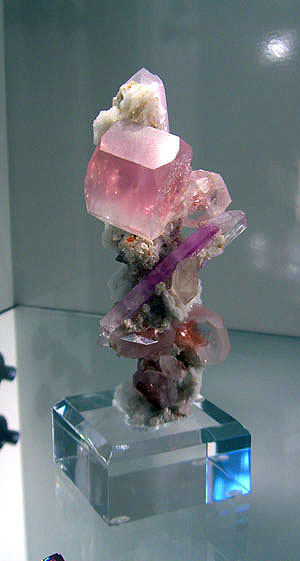 |
| Morganite and kunzite. Another jazzy composition by Mother Nature. (Photo: Bill Larson) |
Friday the special cases are now finished, and this is dealer day, fun to walk and talk. Lots of fine minerals are now set up in all the dealers’ booths. I meet up with Tom Moore, who is writing the Munich show up for The Mineralogical Record, and we compare notes on new finds—few this year, but interesting. See his column in the next issue!
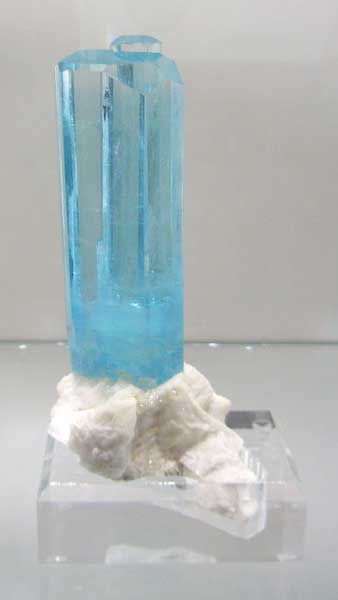 |
| Aquamarine. Limpid and lovely. (Photo: Bill Larson) |
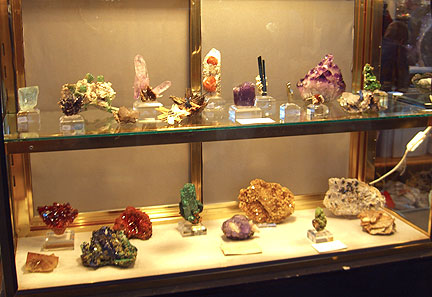 |
| A dealer’s case shows the variety of offerings at the Munich show. (Photo: Bill Larson) |
[back to top]
 |
What is billed as The First International Pearl Convention is scheduled to be held in Dubai, November 19–22, 2007. The Convention website has sketchy details under the “Events” heading. A registration form indicates activities to include a pearl auction, and visits to a pearl museum and pearl farm.
The convention is sponsored by the Pearl Revival Committee, which states its purpose as the revival of the “distinguished pearling tradition” of the United Arab Emirates, and to “embed it as the keystone of the country’s cultural identity.” [back to top]
Phenomenal gemstones, including star sapphires, surface through in-depth mining efforts and percolate through the hands of gem cutters and merchants, eventually finding their way into the hands of the collector. This month we dig a little deeper down the rabbit hole and find a natural padparadsha star sapphire from Sri Lanka. A phenomenal phenomenon with a peach hue and a nicely formed six-rayed star.
 |
| Star Sapphire, 10.28 cts., 12.64 x 9.84 x 7.34 mm. A fine example of high saturation and crystalline clarity. This stone has been sold. (Photo: Wimon Manorotkul) |
Fine star sapphires of any color are quite rare to begin with, captivating collectors of the rare and unusual. The large size, natural pinkish-peach color, translucency, and the presence of the star all contribute to the rarity and desirability of this jewel.
 |
| This sapphire is screwed. A bizarre negative crystal seems to have grown in a corkscrew-like pattern (Photo: Pala International) |
In our quest to understand the complete story of gemstones we look internally to fully appreciate their external beauty. We’ve set up a new gallery to exhibit the educational and fascinating inclusions that aid us in our work. All the gemstones photographed have passed through Pala’s hands in the past year. The photos were taken in an effort to learn and appreciate the gems that we see every day. See more microphotos here.
We can use the internal characteristics of gemstones to extrapolate the conditions in which they were formed, including temperature and pressure, and how that relates to the geological and geographical region they may have been associated with. The original locality of a particular gemstone can be traced back to the source by diagnostic features like a specific solid crystal inclusion or the presence of a 3-phase inclusion, just to name a couple.
The internal world of gemstones reveals mineralogical clues to trace a gem’s origin and what has happened to it on its way from the mine to the jeweler. Enhancements and treatments are even more of a factor today since the average gem collector has the infinite resources of the Internet to research and explore the secrets of the gem trade. Understanding internal characteristics can help identify the presence of heat treatment and distinguish a natural from a synthetic.
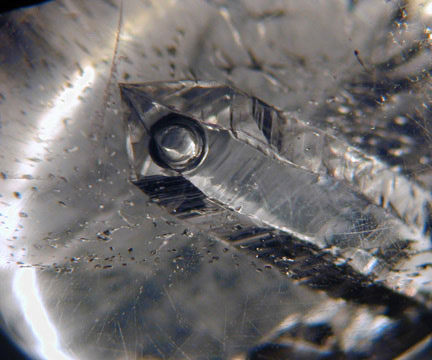 |
| One-eyed Willie. A bubble in a negative crystal within a quartz cabochon. (Photo: Wimon Manorotkul) |
The father of modern day inclusion studies is the late Dr. Eduard J. Gübelin. His extensive research and cataloging of gems and their inclusions has established a standard by which gems are evaluated. His work has been materialized through the Photoatlas of Inclusions in Gemstones, Volumes I & II. The research and publication of these books was made possible by his partner John I. Koivula. You can find a copy of these books and more about the coauthor J. I. Koivula here. Gübelin’s studies began during the winter of 1936–1937 and continued throughout his life. His work on gemstone inclusions includes 10,000 photomicrographs. Read more on Dr. Gübelin here.
 |
| A really good night inside a sunstone amongst the hematite platelets. This phenomenon is produced by interference colors from oblique illumination. (Photo: Wimon Manorotkul) |
We will revisit some of these classic internal features that originally inspired Dr. Gübelin to delve into the microscopic world. We also hope to bring the importance of this knowledge to the forefront of collecting and buying gemstones because of the overwhelming amount of treatments, synthetics, and imitations that are circulating in the gem trade. While highlighting some of the scientific aspects of gemology we also want to share the beauty and intrigue that can be found as we look just a little bit closer and expand our understanding of the genesis of gemstones.
 |
| Pick one (from top to bottom): Inventory #15966 Inventory #15960 Inventory #15965. (Photos: Wimon Manorotkul) |
On October 7, National Jeweler reported that a remarkable red spinel crystal was stumbled upon in a farmer’s field in Mahenge, Tanzania. A group of miners discovered this enormous pyramid-shaped crystal in an alluvial deposit at a depth of 10 meters. This single spinel crystal weighed in at over 52 kilograms.
This discovery created a serious commotion, and the original miners were able to escape the area, somehow hiding the oversized jewel. The crystal itself was overall very included, but there were plenty of gemmy sections that should produce thousands of carats of faceting material. There are even some spinels being fashioned into gems 20 cts. and above, which is very unusual for spinels.
The color being brought to life out of this particular crystal has very vibrant and special qualities. The color seems to dance between a peachy orange and a pinkish red, and almost have a neon-type quality. Pala was able to acquire some of the new spinels from this spectacular find in Tanzania. These three beauties (pictured at left) are an exciting new addition to our extensive collection of spinels from around the world. Source material from David Weinberg at Multicolour.
See Pala’s selection of spinels here. [back to top]
 |
Sotheby’s Geneva announced the results of its November 14 sale, including the “Chloe Diamond,” which was purchased by Georges Marciano, founder of Guess? Jeans, who paid $16,189,769 for the gemstone. The amount was the highest price paid per carat for a white (colorless) diamond at auction—$191,980 per carat—and the second highest for a diamond at auction. It was Marciano who named the diamond “Chloe,” after his daughter. See more on the sale here. See a photo here. [back to top]
Christie’s Geneva announced a record-setting sale for a red diamond, on Thursday, November 15. On offer was the largest red diamond ever to appear for sale. Set in a ring, this highly saturated octagonal-shaped fancy purplish red diamond weighs 2.26 carats. It was purchased by British jeweler Laurence Graff for 2.97 million Swiss francs ($2.6 million). With this sale Christie’s topped its own red diamond price-per-carat record, set in 1987 at $1 million per carat, for a stone weighing 0.95 carats. For photo and details see Christie’s and Reuters. [back to top]
 |
Douglas K. Hucker as been reappointed as American Gem Trade Association (AGTA) Chief Executive Officer, according to a November 7 press release. Less than six months have passed since Hucker resigned as CEO, which we reported in June, and no replacement for Hucker had ever been named. For a personal overview of Hucker’s career, see Frank Dallahan’s September 1 story in Jewelers Circular Keystone. (Dallahan is now President and CEO of American Gem Society Laboratories.) [back to top]
In related news, the AGTA Gemological Testing Center announced an offer of Tanzanite Grading Reports utilizing a tanzanite-specific grading system that is internationally recognized. The reports are being issued in cooperation with the Tanzanite Foundation. See the November 12 press release.
AGTA-GTC’s Richard W. Hughes recently returned from Tanzania and Kenya. We trust he’ll let us in on a report of his travels as soon as they are available... [back to top]
 |
| ICA President Andrew Cody (left) presents Mayor Jose Bonafacio Mourao of Governador Valadares with a check from ICA for purchase of computer equipment at schools in the Tourmalina district of Minas Gerais, Brazil. |
As of this past summer’s International Colored Gemstone Association (ICA) Congress in Dubai, ICA has a new President, Andrew Cody, of Australia’s Cody Opal. While the hand at the helm may have changed, ICA’s commitment to social responsibility has not wavered in the lands from which come our industry’s treasures.
On October 23, ICA announced donations made to schools in the emerald mining areas of Colombia. In June, Cody made a donation on behalf of ICA towards the purchase of computer equipment for schools in the gem-rich mining district of Minas Gerais. Computers also were donated to schools in Kenyan mining areas. And ICA is supporting the construction of teachers’ housing in a mining district of Tanzania. See the full story here. [back to top]
Burma’s postponed “mid-year” sale has commenced despite calls for a boycott by activists, according to an Associated Press story this week. Anticipation of demand for jade during the upcoming Olympic Games in China is one reason why buyers may not be staying away, according to JCK’s Gary Roskin. The online weekly Myanmar Times also was optimistic about the industry.
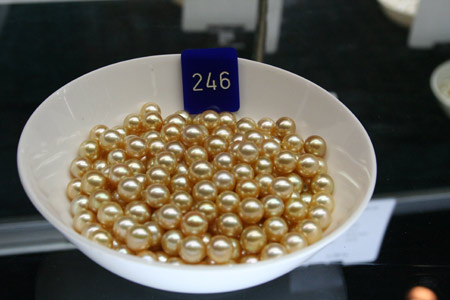 |
| Pearl lots that are to be auctioned are displayed at the Mid-Year Emporium in Yangon Nov. 13, 2007. (Photo: Xinhua) |
From an attendance perspective, the mid-year sale may be affected. Last year’s October sale drew more than 3,000 attendees—a record—as reported by The Myanmar Times. The same news source’s pre-sale estimate figured on only 2,000 attendees at the current sale. A New York Times story gives a mixed picture: attendance is at 2,667, but business was “very slow, not like before,” according to a Yangon gem merchant. [back to top]
The Irrawaddy published a story on gem trading businessman Nay Win Tun, owner of the largest such business in Burma. “He manages ruby and jade mines located in Pha Kant and Tawmaw in Kachin State; Khamti in Sagaing Division; Mogok in Mandalay Division; and Mongshu in Shan State.” [back to top]
— End November Newsletter • Published 11/18/07 —
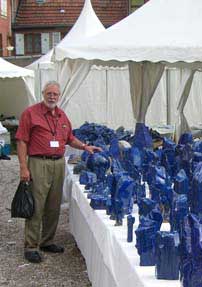 |
| Herb Obodda at this year’s show in Sainte-Marie-aux-Mines. He is a featured speaker this year in Munich. (Photo: Bill Larson) |
We neglected to mention this in the Oct./Nov. Mineral News...
Pala International’s Bill Larson will attend this major mineral show.
This year’s special exhibit is titled “Precious Stones of the Himalayas” and will include the “King of Asia,” a completely undamaged white tourmaline with a deep red center, which weighs over 40 kg, and the largest aquamarine crystal in the world. Also featured will be the legendary Herb Obodda, an authority on the area, who celebrates 50 years in the business this year.
For more information visit the show website. See the Pala International Show Schedule for future events. [back to top]
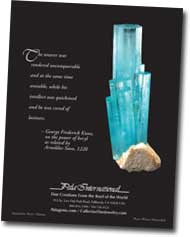 |
| See our ad in this year’s program. |
Taafeite is one of our planet’s extremely rare creations. It is named after its discoverer Count Edward Taafe, a Bohemian-Irish gemologist. Taafeite was originally found mixed within a parcel of mauve-colored spinels. Upon closer examination, it can be easily differentiated from spinel by using a polariscope or dichroscope.
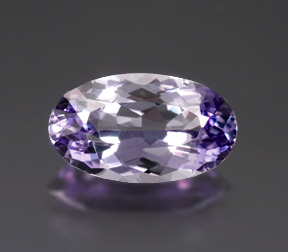 |
| Sri Lankan taafeite, 3.28 cts., 12.23 x 7.24 x 4.82 mm. Inventory #15836. A fine example of high saturation and crystalline clarity. (Photo: Wimon Manorotkul) |
Taafeite is known to occur in Russia, China, Burma, and Sri Lanka. According to the Color Encyclopedia of Gemstones by Dr. Joel E. Arem, in 1987 there were around 50 true taafeites that had been properly identified. This month’s beauty comes to us from Sri Lanka, and shows an incredible saturation and a luscious mauve hue. See Pala’s selection of taafeites here.
Interested? Select the inventory link above for pricing, email us, or give us a call. [back to top]
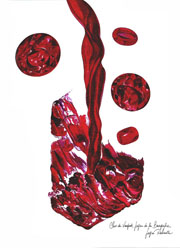 |
Pala’s Mineral News readers have been kept up-to-date regarding a remarkable exhibition of fine wines and gemstones in Dijon, France, to which Pala has supplied over $1 million worth of gemstones and mineral specimens.
The show is produced in partnership with the French National Museum of Natural History and the Interprofessional Bureau for Burgundy Wines, as well as the Jules Guyot Institute (a winemaking school) and the UNESCO Chair of Wines and Culture (a cultural and scientific networking body). The show continues through December 9, 2007.
Last month, Bill returned to France to be inducted into the prestigious wine tasters’ fraternity of the Burgundy region, the Confrérie des Chevaliers du Tastevin (Brotherhood of the Knights of the Tastevin [tasting cup]). He was honored for his contributions to the museums of France.
 |
| Château du Clos de Vougeot, the location of the ceremony, as seen through the entrance. The château and its vineyards were the property of a Cistercian abbey until the French Revolution. The vineyard was founded in 1098. (Photo: Visitor’s Guide) |
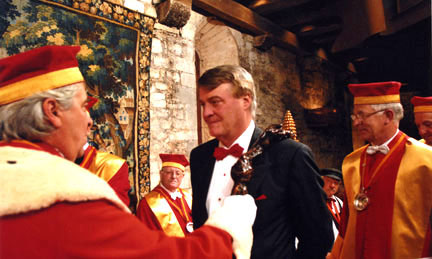 |
| The Chevalier assuming the position. Bill Larson is about to receive the tastevin (tasting cup) of this “Brotherhood of Knights.” (Photo courtesy Confrérie des Chevaliers du Tastevin) |
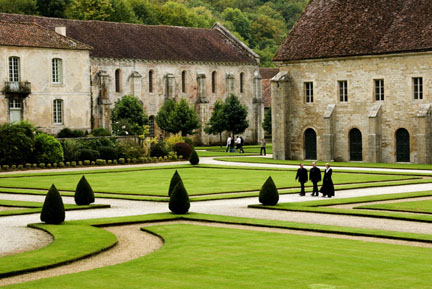 |
| In the footsteps of St. Bernard. Although the medieval saint might not actually have set foot on this location, he founded the abbey whose monks went on to occupy this site in Fontenay, Burgundy (not to be confused with the abbey owned by the Confrérie). In the foreground, “Flashes of Colour” exhibition curator Gian Carlo Parodi (Lecturer at the National Museum of Natural History, Paris), National Museum of Natural History Professor and Chief-Curator François Farges, and Gian Carlo’s friend Sophie stroll the grounds of what is now a private residence. Its owners were hosting a symposium on Hildegard of Bingen, who, while best known for her music, also wrote on physics, chemistry, mineralogy, and geology. (Photo: Bill Larson) |
[back to top]
A new benchmark in the fancy colored diamond market was set by a 6.04-ct. flawless natural blue diamond, at the Sotheby’s auction in Hong Kong on October 8. The diamond was graded as a fancy vivid and was fashioned into a precise emerald cut, which apparently added to its overall beauty. This extremely rare jewel was sold for $7.98 million, which comes out to $1.32 million per carat. This per-carat amount breaks the previous record set by the 0.90-ct. Hancock red diamond that sold for $926,000 per carat twenty years ago.
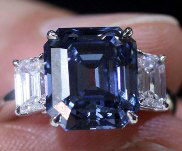 |
This blue diamond was bought by Moussaieff Jewellers of London from a private Asian collector at the auction. A feverous bidding war escalated the price to its record-breaking level. This Hong Kong auction raised a total of $40.8 million just in the gems and jewelry department. Also noteworthy was a 47.60-ct. vivid green Colombian emerald that sold for $2.64 million. This emerald was in a diamond sautoir and was owned by the famous American song writer and lyricist Irving Berlin. An exceptional 7.20-ct. ruby in a diamond setting was also sold for $1.87 million. The ring was designed by James de Givenchy, which showcased the ruby in an innovative micropavé diamond frame.
Next month Sotheby’s will be featuring a 84.37-ct. D flawless diamond at the Geneva auction. Sotheby’s is saying this is the largest fine quality diamond they have put up for auction, which has an estimated value from $12 to $14 million. [back to top]
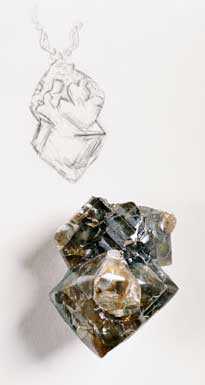 |
| Stocking stuffer? Neiman Marcus is offering this remarkable diamond crystal at a starting price of $1 million. Dimensions 41 x 34 cm. (Photo: Neiman Marcus) |
As people look for the next generation of “rare and unusual,” only sometimes do we look back toward the source for new inspiration. Raw un-cut diamond crystals are one of many design-based efforts to show gemstones in their natural state. We can imagine early humans simply being drawn to sparkly minerals and feeling the impulse to adorn themselves and show off their newly found treasures. This trend of using natural crystals in jewelry has become very in-style as well as an exciting way to display and enjoy Mother Nature’s fine creations.
This photograph was taken from the recently released Neiman Marcus Christmas Book showing a rough diamond crystal with a sketch for a design. Diamond in the Rough® will be taking on the design aspects after this jewel finds a home. The diamond shown is apparently one of the largest diamond crystals unearthed. Weighing in at 305.18 cts. this oversized beauty is said to throw off golden, green, and amber hues. Starting price for this diamond is $1 million. [back to top]
 |
President of the American Gem Trade Association (AGTA), Richard “Rick” Krementz, resigned his office, according to an October 5 press release. Krementz offered his resignation during a conference call with the Board of Directors. Krementz formerly headed the eponymous Richard Krementz Gemstones. His new venture is a Nuclear Regulatory Commission-licensed irradiation certification service, GemClear, LLC, according to his response to an entry on the blog of Gary Roskin, Gemstone Editor of JCK Magazine.
The office of President will be filled by AGTA First Vice Chairman Barbara Lawrence, who is President of Boston Gems and Findings, Inc. She will hold the post through the remainder of the current term, February 2009.
As with the resignation of AGTA CEO Douglas C. Hucker, which we reported in June, no reason for the resignation was given. According to the AGTA website, a replacement for Hucker still has not been named. [back to top]
It being two weeks before Halloween, we just couldn’t resist the title...
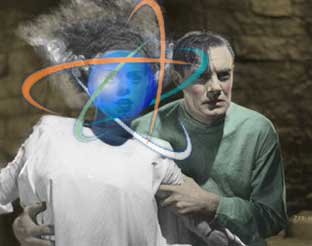 |
Today, the federal Nuclear Regulatory Commission issued a transition plan whereby it will assume regulatory responsibility for irradiated material previously managed by the states. The issuance of new rules regarding irradiation of gemstones, including blue topaz, is the latest in a flurry of activity by the body in the last few months.
Like a compliant bride to the blue topaz trade, the NRC until recently had quietly ignored its own regulations in regard to enforcement. Co-dependent no more, as recent articles in Colored Stone and Modern Jeweler indicate, the regulatory agency is taking the issue of gemstone irradiation seriously. They are, in fact, extending regulation to accelerator-treated stones as well as nuclear reactor-irradiated material. Certification of topaz stocks is a possibility as well.
There’s too much news to include right here, so read all about it in our continuing coverage of the irradiation issue, “NRC: Bride of Franken-stone No More.” [back to top]
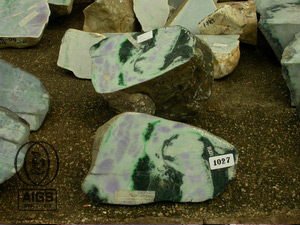 |
| Tricolor. When cut, this boulder revealed dark green, light green, and lavender areas. (Photo: Vincent Pardieu, 2004.) |
As all the world knows by now fuel prices increased in Burma on August 15, sending people into the streets. On September 17, The Myanmar Times ran a story with this leading line: “Hefty fuel price rises last month will not dampen production of jade and gemstones in Myanmar, several gem industry sources said last week.”
According to the article, the mining outfits have no real choice. Contracts with the government are awarded for three years, so they cannot afford to stall production, waiting for fuel prices to fall. Of course, increased costs will be passed on to the buyers. [back to top]
During the last two months, the military rulers of Burma have done their best to put up a front of business-as-usual. Just after we sent our last edition of Gem News, it was announced that Burma would once again hold its customary “mid-year” gem and jade sale (the fifth this year, according to this same source, Agence France-Presse). Trouble is, the mid-year sale usually takes place in October. This auction is now postponed until November. Some have called for a boycott of the sale. Last week, however, Burma officials declared that the sale will go on as planned.
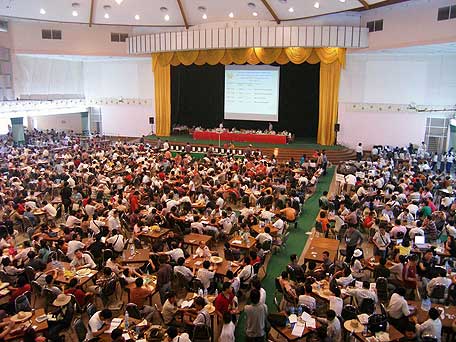 |
| Going once... Auction hall at the March 2007 Myanma Gems Emporium. (Photos: Mark H. Smith, Thai Lanka Trading Ltd. Part.) |
Gem and jewelry complex to open. Government officials expect to have one building of a Rangoon gem and jewelry complex completed by the mid-year auction, according to The Irrawaddy.
The Rangoon-based Weekly Eleven news journal reported on Wednesday that more than 30 acres in Mayangone Township in Rangoon, including the Myanmar Convention Centre and the Royal Ruby Jade Hotel, will become a gem and jewelry trade area.
[back to top]
[back to top]
— End October Newsletter • Published 10/18/07 —
A common gemstone to some but a real treasure to the purveyors of exceptional gem quality. Peridot is the gem variety of forsterite of the olivine group, and it is found in igneous and some metamorphic rock types. Peridot in its most basic form is a relatively common mineral when looking at the big picture of our Earth. As we trace peridot’s formation from tiny crystals scattered through massive rocks to larger well-formed crystals we began to see the rarity increase. Larger gemmy crystals are quite rare, in fact, and can draw much higher prices than their micro counterparts.
 |
| Peridot, 36.70 cts., 19.67 x 17.74 x 13.74 mm. Search on inventory number 15529. (Photo: Wimon Manorotkul) |
In last month’s Pakistan Update, we included a nice 13-carat peridot, and got quite a few “clicks.” This month we feature an exquisite example of big and beautiful. This 36.70-carat Pakistani peridot exhibits some of the most exceptional characteristics of fine material. Super-saturated yellowish-green hue, with flawless clarity, and a precision cushion cut. See more peridot from our inventory here.
Read more on peridot in Pala’s Buying Guide, and the history of its discovery from Peter Bancroft’s Gem & Crystal Treasures,
Interested? Select the inventory link above for pricing, email us, or give us a call. [back to top]
 |
While attending gem shows this year, the awareness of Palagems.com seems apparent by the numbers of people complimenting us on our website. Here are just a few of responses we received regarding our site and staff.
It was a pleasure talking with you at the Vegas show. I just wanted to say how much I appreciate your quality website, sharing your experience and beautiful gems with not only us but our clients. It is such a pleasure knowing that I can send my clients to your site and be comfortable with the knowledge that they can get the full benefit of your expertise and not have to worry that you will snipe my clients! Thank you and AMEN! —Wink Jones, Winfield’s of Boise, Idaho
Good morning. As a gemmologist I often visit your website. It is an inspiration. I speak on behalf of the Academy for Mineralogy in Antwerp, Belgium. We are active in the field of gemmology, mineralogy, and paleontology. We have a course on gemmology and are member of the Federation for European Education in Gemmology. Our goals in the field of gemmology are: • To help the trade and the buying public professionally and ethically • To serve the industry • To help the trade and the buying people you to identify natural, synthetic and treated gemstones • ACAM is a transfer of gemmological skills to the marketplace. Please visit our website. Would it be possible to add an additional link on your website with our web address? We would be very grateful. Many thanks for your feedback. —Guy Lalous, ACAM Delegate at FEEG
Hey I just wanted to let you know that I have been searching the Net for info regarding spessartite garnet and your website has by far been the most helpful. —Andrew, via AIM
I met Gabrièl Mattice when I worked for Neiman-Marcus at the Lenox Square mall, Atlanta, Ga. She was extremely knowledgeable and professional. I always like to extend and increase my knowledge base whenever possible and trust Pala International for the facts. —Wesley Dennison, Gem Shopping Network
And be sure to check out the Pala International Mail Bag—just updated. [back to top]
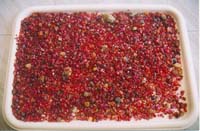 |
Pala international President Bill Larson made it back again from Burma with new stories, wonderful pictures, and of course some beautiful gems from this exotic land. The photos included in this section were a gift from Kyaw Thu, one of Bill’s friends and trusted guides to the Burmese gem market. These pictures highlight various gem mining regions around Burma, many of which are restricted to foreign visitation. So we can at least imagine what some of these enchanted lands are like surrounding some of the most richly mineralized areas on the planet.
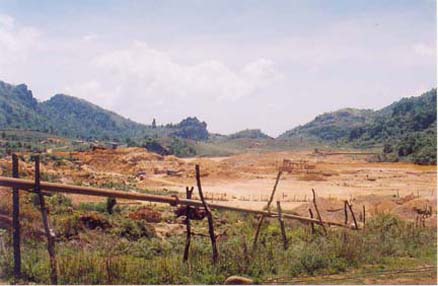 |
| Nice view. Sticks and stones, with a little metal pipe, will have to do, as an aid to mining. (Photo courtesy Kyaw Thu) |
Several pictures depict the crude methods by which gems are extracted, processed, and cleaned. A lot of hard labor is done in precarious places, under poor conditions, but with the driving force to “get lucky.”
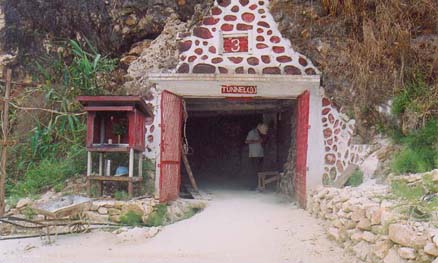 |
| Come on in—the spinels are fine (Photo courtesy Kyaw Thu) |
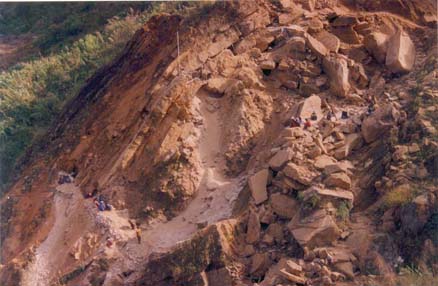 |
| On the edge of a cliff, with a striking fold above, the locals dig in. (Photo courtesy Kyaw Thu) |
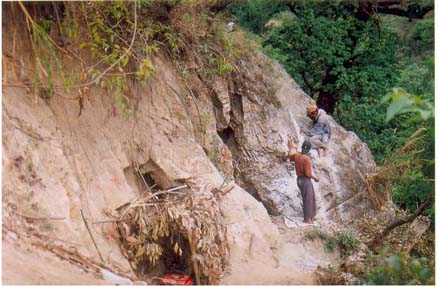 |
| Work & Home. These two probably work all day perched on the cliff and take the commuter trail around the corner to their homely cave. (Photo courtesy Kyaw Thu) |
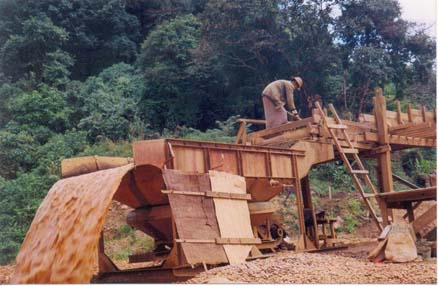 |
| The work continues with sorting and sifting in this primitive slough system. (Photo courtesy Kyaw Thu) |
[back to top]
While Bill was in Asia, he couldn’t resist this fine colored poudretteite from Mogok, Burma. Acquired in Thailand, this stone is 2.06 carats, dimensions 10.5 x 9 x 6 mm.
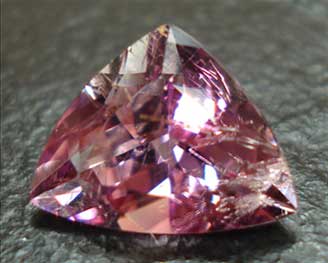 |
| Beyond the pale. The gemstone pictured here is remarkable for its distinctive color. At the time of our October 2005 featured stone—a pale pink 3.8-ct. Mogok poudretteite—it was one of less than ten known faceted stones. |
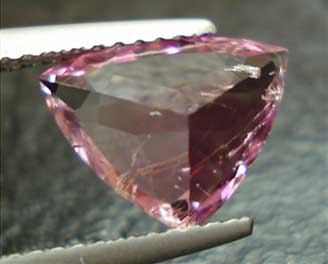 |
Bill opines that, because of the exquisite color, this is perhaps the second finest cut poudretteite known. [back to top]
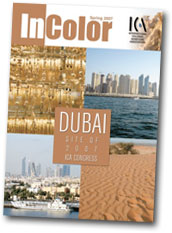 |
The Spring 2007 issue of the International Colored Gemstone Association’s publication, InColor, is available to read online. It’s in RealRead format, which simulates the page-turning experience of a hard-copy magazine.
These are some of the items of interest to Pala Gem News readers:
A major exhibition of jade opened earlier this week, on September 12, at the Beijing Botanical Garden. Our only reference available was a three-page pictorial from the show on China News Service’s Chinanews.com.
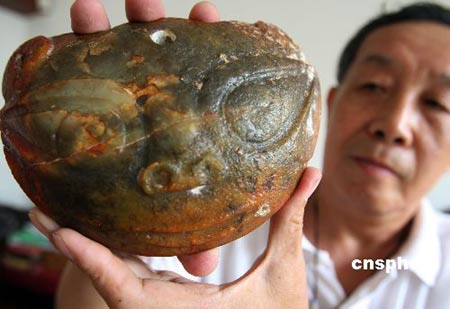 |
| Jovial jade. This is one of nearly 400 pieces of jade assembled for the Botanical Garden show. The exhibit looks back 100 to 5,000 years. (Photo: China News Service) |
On August 21, a remarkable emerald pendant was shown at a jewelry shop at Ningbo, in eastern China’s Zhejiang Province. No further details were available on the Web.
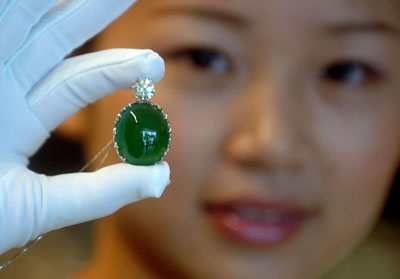 |
| Jaw dropper. The pendant, weighing 27.7 grams (138.5 carats), and with 221 diamonds encircling the emerald, is valued at $3.75 million. (Photo: People’s Daily Online) |
Photographs of the pendant being displayed are posted on People’s Daily Online. Note: This link is not Mac-friendly. [back to top]
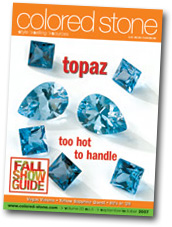 |
The issues surrounding irradiated gemstones, including blue topaz in particular, continue to be a topic of discussion. Since our last Gem News, two more articles on the subject have appeared on the website of Colored Stone.
“Will Blue Topaz be ‘X-rated’ for X-mas?” is the provocative title of David Federman’s August 17 article, in which he covers testing issues raised by the U.S. Nuclear Regulatory Commission (NRC), which met with industry leaders in late July. The complication inherent in the testing of mounted stones is just one wrinkle handled by the article. Prospective NRC testing centers also are discussed.
Federman’s August 28 follow-up discusses “coated and diffused” topaz. Such non-irradiated topaz can be offered as an option while the dust settles around the NRC. Coatings in the past have scratched off easily, but subsequent technologies are proving more resilient. According to an August 22 report by the American Gem Trade Association Gemological Testing Center:
We have analyzed some of these samples and found out that indeed the coloring agent does not come off as easily as in the usual coated topaz. We tried scratching and leaving the samples in acetone without affecting the coating.
We picked up a copy of the September/October “Fall Show Guide” issue of Colored Stone (pictured above) today in Denver at the Colorado Mineral & Fossil Show. Look for the cover article, “Too Hot to Handle: The Gem Trade’s Topaz Trauma.” [back to top]
As we go to press, Burma is on tsunami alert after a powerful earthquake hit Indonesia’s island of Sumatra. An earthquake of the human kind, however, continues to rock the country. Last week, Buddhist monks set fire to officials’ vehicles after seizing them, in a response to earlier monastic protests against rising fuel prices. Monks and civilians have been on the march since fuel prices rose—previously unannounced—500 percent in mid-August. This week, phone service was cut off for journalists.
 |
Bloggers, meanwhile, are tap-tap-tapping while Yangon rocks. MySuboo launched September 1 and Myanmarblogger.org is “parked” for future startup, all under the perky endorsement of the government. A blogger in Mogok, however, has not been so lucky. According to The Irrawaddy, blogger Thar Phyu’s computer was seized and checked, and he was warned after being found without a license for his computer shop. Phyu had “recently reported about the flooding in Mogok as well as demonstrations against the hike in fuel prices.” See Mogok Media (tag line: “Information from Rubyland”) for more information. If your Burmese is a little rusty, you can still view the photos of recent flooding in the area. Scroll down to see a map of the Mogok mining areas.
For a mention of protests in Mogok, see this August 27 Associated Press story.
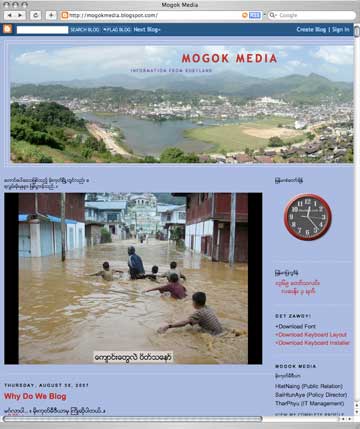 |
All of this was the backdrop to Bill Larson’s recent trip to Burma (see above). [back to top]
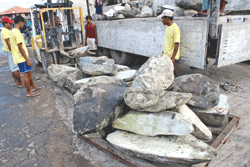 |
| Jade blocks unloaded for sale before June 2006 sale in Yangon. (Photo: Hein Latt Aung, The Myanmar Times) |
A September 3 story in the online weekly The Myanmar Times states that strong demand from China for jade and other gems is expected to result in “record foreign exchange earnings.”
The story includes local Customs Department trade figures:
While jade has been a big seller, gems have taken a back seat.
Officials have attributed the decline in gem sales to a cooling off of the Thai market, which has traditionally been the biggest buyer of Myanmar gems.
The MGE has been trying to drum up interest in the country’s precious stones by encouraging traders to present their finest rubies at state-run auctions.
No sales information was available at press time regarding last month’s 23rd Gems & Jade Sales 2007 held by the Union of Myanmar Economic Holdings. [back to top]
— End September Newsletter • Published 9/15/07 —
Last week, a diamond-encrusted skull by artist Damien Hirst sold for $100 million in London, according to Agence France-Presse. The sale set a record for the price of a work of art by a living artist. The artwork, entitled For the Love of God, is composed of a skull cast in platinum and encrusted with 8,601 diamonds. Hirst also holds the record for a work by a living artist sold at auction.
2015.3 | 2015.2 | 2015.1
2014.3 | 2014.2 | 2014.1 | 2013.3 | 2013.2 | 2013.1 | 2012.3 | 2012.2 | 2012.1
2011.3 | 2011.2 | 2011.1 | 2010.3 | 2010.2 | 2010.1 | 2009.3 | 2009.2 | 2009.1
2008.3 | 2008.2 | 2008.1 | 2007.3 | 2007.2 | 2007.1 | 2006.3 | 2006.2 | 2006.1
2005 | 2004 | 2003 | 2002 | 2001 | 2000
Note: Palagems.com selects much of its material in the interest of fostering a stimulating discourse on the topics of gems, gemology, and the gemstone industry. Therefore the opinions expressed here are not necessarily those held by the proprietors of Palagems.com. We welcome your feedback.